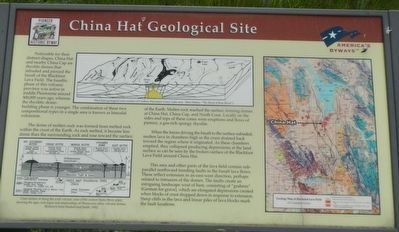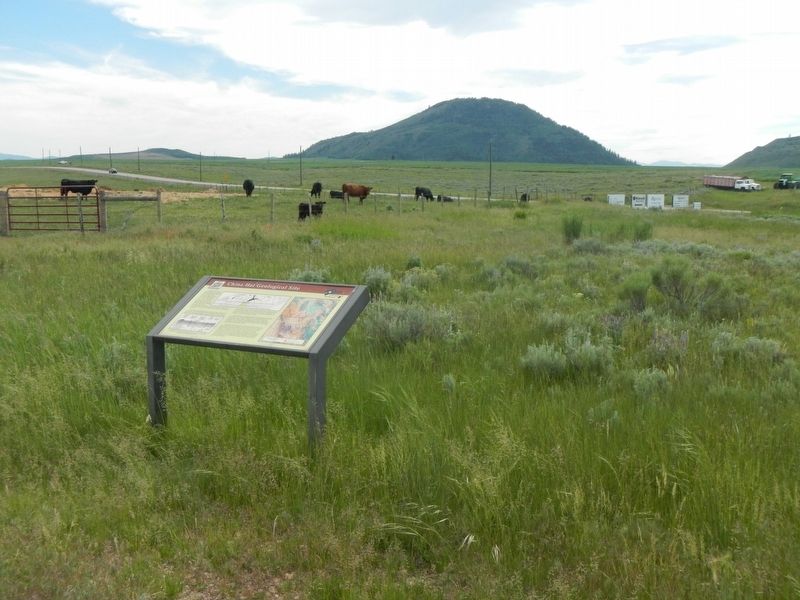Near Soda Springs in Caribou County, Idaho — The American West (Mountains)
China Hat Geological Site

Photographed By Barry Swackhamer, June 21, 2017
1. China Hat Geological Site Marker
Captions: (bottom left) Cross section of along the axial volcanic zone of the eastern Snake River plain, showing the ages, rock types and relationships of Pleistocene silicic volcanic domes.; (top center) West-East geological cross section of Cariboo Mountain-Grays Lake area.; (right) Geological Map of Blackfoot Lava Field.
The dome of molten rock was formed from melted rock within the crust of the Earth. As rock melted, it became less dense than the surrounding rock and rose toward the surface of the Earth. Molten rock reached the surface, forming domes at China Hat, China Cap, and North Cone. Locally on the sides and tops of these cones were eruptions and flows of pumice, a gas-rich spongy rhyolite.
When the forces driving the basalt to the surface subsided, molten lava chambers high in the crust drained back toward the region where it originated. As these chambers emptied, they collapsed producing depressions at the land surface as a can be seen by the broken surface of the Blackfoot Lava Field around China Hat.
This area and other parts of the lava field contain sub-parallel northward trending faults in the basalt lave flows. These reflect extension in an east-west direction, perhaps related to intrusion of the domes. The faults create an intriguing landscape west of here, consisting of "grabens" (German of grave). which are elongated depressions created when blocks of crust dropped down in response to extension. Steep cliffs in the lava and linear piles of lava blocks mark the fault locations.
Topics. This historical marker is listed in these topic lists: Natural Features • Paleontology.
Location. 42° 49.163′ N, 111° 33.588′ W. Marker is near Soda Springs, Idaho, in Caribou County. Marker is on State Highway 34 near Blackfoot River Road, on the right when traveling west. Touch for map. Marker is at or near this postal address: 2780 Idaho Highway 34, Soda Springs ID 83276, United States of America. Touch for directions.
Other nearby markers. At least 8 other markers are within 12 miles of this marker, measured as the crow flies. Henry-Chester Country Store (approx. 6.3 miles away); Pioneer Cedar Cemetery (approx. 11.2 miles away); Travertine Terraces - World Famous Water (approx. 11.4 miles away); Caribou Mountain (approx. 11˝ miles away); "It Roars Like a Mad Dragon" (approx. 11˝ miles away); The Springs of Soda Springs (approx. 11˝ miles away); George W. and Leah Wallet Gorton (approx. 11˝ miles away); Ground Observer Corps National Planning (approx. 11˝ miles away). Touch for a list and map of all markers in Soda Springs.
Credits. This page was last revised on July 23, 2017. It was originally submitted on July 23, 2017, by Barry Swackhamer of Brentwood, California. This page has been viewed 474 times since then and 47 times this year. Photos: 1, 2. submitted on July 23, 2017, by Barry Swackhamer of Brentwood, California.
